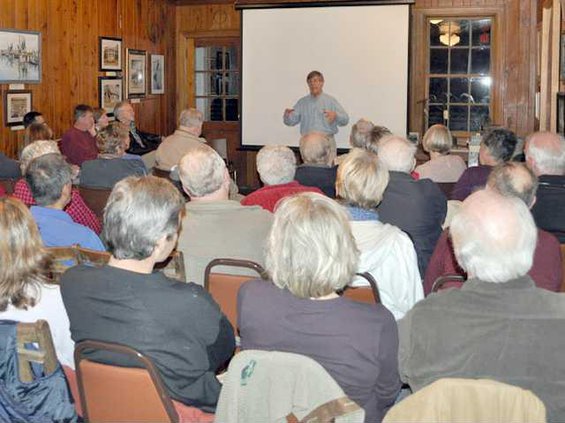Local author and historian Buddy Sullivan kicked off the Richmond Hill Historical Society’s 2012 lecture series Thursday evening at the Richmond Hill Museum with a talk on “Spanish Settlements in Coastal Georgia from 1526 to 1742.”
Sullivan, who has published 14 books on subjects related to Georgia history, traced the activity of Spanish settlers in Coastal Georgia and examined artifacts left in their wake.
According to Sullivan, more than 500 Spanish settlers led by explorer Lucas Vázquez de Ayllón settled in Coastal Georgia, on or near Sapelo Island, 200 years prior to the arrival of British colonists.
“Ayllón showed up in 1526,” he told the crowd of nearly 50. “That’s 34 years after Columbus, 39 years before St. Augustine, 81 years before Jamestown and 207 years before the landing of Oglethorpe. And yet, most people know nothing of the Spanish living in Georgia.”
Ayllón’s settlers did not fare well in this area, however. Due to hunger, disease and the inability to adapt to their new surroundings, the majority of the settlers died within months of arriving. Those who survived fled to Hispaniola, the island containing Haiti and the Dominican Republic.
Historians and archeologists have not yet discovered the location of the settlement.
“We know it’s there from records, but we haven’t found it yet,” said Sullivan. “Someday though, we will. People are looking all around Sapelo Sound, and some are searching the mainland.”
But the demise of Ayllón’s settlement did not mark the end of Spanish activity in Georgia. Spanish missions, like the one discovered by archeologist David Hurst Thomas on St. Catherines Island in 1986, began appearing in Georgia later in the 16th century.
“The idea of the missions was to educate and Christianize all of the Indians on the Georgia coast,” said Sullivan.
He said the Spanish presence in Georgia lasted until the 18th century. Conflicts with British colonists from South Carolina and the newly colonized Georgia, escalated into war.
“The final blow to Spanish activity in Coastal Georgia came as a result of the Battle of the Bloody Marsh in 1742,” Sullivan said. “The British victory at the battle, which was a part of the War of Jenkin’s Ear, permanently solidified British rule in Georgia and drove the Spanish from the colony.
Following the lecture, Richmond Hill Historical Society President Sarah Volker called Sullivan’s talk “educational and entertaining.”
“I had no idea that the Spanish were here for over 200 years before Oglethorpe’s boots ever hit the shores. That’s just amazing to me,” she said.
“There really is no legacy here from the Spanish. All we think about is the English colonies. I’m glad to know more now.”
Historical Society member Steve Berg, who lives in Midway, agreed.
“Buddy is excellent. He’s done his research, and he’s very engaged with the history of the area,” he said.
The society’s next lecture is in February with Meredith Devendorf, historian and vice president of Dunham Farms in Midway as the guest speaker.
Spanish influence on area in spotlight
Historian looks into European settlement of area


Sign up for our e-newsletters